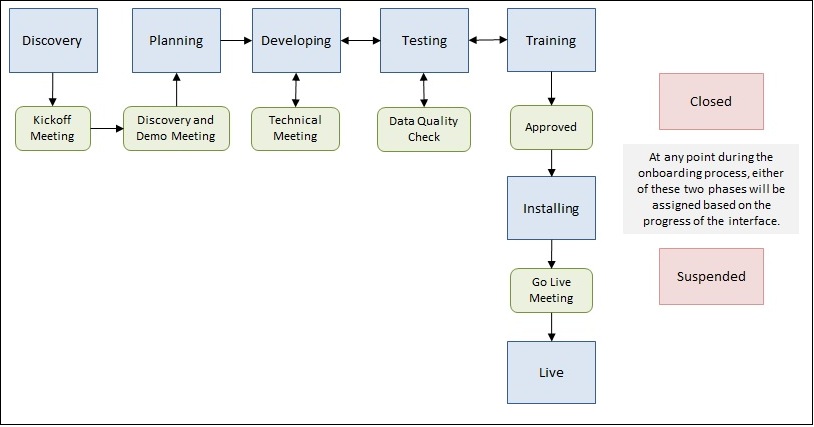 PHC-Hub 4.17.3 User Guide PHC-Hub 4.17.3 User Guide |
Project Phases in Detail
An interface project should be broken into phases. Tracking a project
by phases indicates how close a project is to completion and helps participants
focus on what needs to be done next. Phases include:
- Discovery
- The project is proposed, but details are unknown. This is an initial
phase and no work has been completed.
- Planning
- After it's decided to move forward with the project, a kickoff meeting
is held and plans are made for the new interface. This meeting must
include both technical and management personnel. If the project is
complicated, the planning stage may include formal documents, technical
meetings, and presentations. Simple projects may require less planning.
- Developing
- If there is technical work involved in a project, it must be developed.
This technical work can happen on either or both sides of the interface.
Developers use the requirements created in the Planning phase to make
changes.
- Testing
- The interface must be tested before development work can be declared
complete. The project may move back and forth between the Developing
and Testing phases until the interface is working properly. Once the
interface is complete, the data quality coming from the source system
needs to be certified that it meets the data quality standards of
the receiving system. For registries receiving data, this means that
the registry does the data quality check. If the data is going from
the registry to another system, then that system does the data quality
check.
- Training
- This phase includes any training that must be completed by the provider
or registry staff. This may include training staff about workflow
issues within a practice or training registry staff on troubleshooting
lot decrementing.
- Installing
- When the software and data has passed inspection, the interface
can be installed. A meeting should be held with the kickoff meeting
participants and the final decision to go live should be made.
- Live
- The interface is now live. The certification process should be repeated
regularly to ensure data quality.
- Closed
- At this phase, all issues have been resolved. Or, there are open
issues but it has been determined that they cannot be resolved.
- Suspended
- If a project starts and issues arise that need to be resolved, the
project can be suspended until the issues have been resolved.
Example project phase workflow:

View Phases
- From the menu, click Phases
> View Phases.
- The list contains the phase name and the total
number of projects in that phase. To work with the phases list:
- Sort using
the buttons in the first column's heading.
- Click a phase
in the list to show its details. Use the drop-down list and View button to view another
phase.
- Click Print Preview to print the list
of phases (Phases view) or projects within a phase (Projects by
Phase view).
Related topics:
 PHC-Hub 4.17.3 User Guide
PHC-Hub 4.17.3 User Guide PHC-Hub 4.17.3 User Guide
PHC-Hub 4.17.3 User Guide